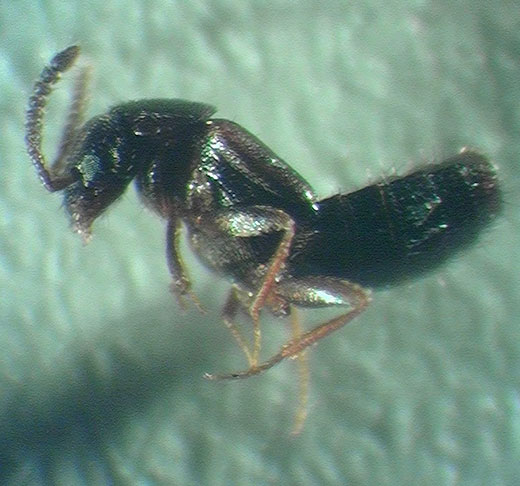
As a biological control agent, rove beetle adults can help to manage populations of fungus gnats and the western flower thrips in a greenhouse environment. (Photo courtesy of Raymond Cloyd, K-State entomology) | Download this photo.
K-State entomologist publishes series on beneficial insects and mites
Publications can help greenhouse producers capitalize on non-chemical means of managing insect and mite pests
Nov. 30, 2023
By Pat Melgares, K-State Research and Extension news service
MANHATTAN, Kan. – For those who grow flowers and vegetables and other horticulture crops in greenhouses, it may seem counter-intuitive to add insects or mites to their production systems.
However, says Kansas State University entomologist Raymond Cloyd, it may be just what is needed to ensure a successful crop production season.
Cloyd has published a seven-part series on beneficial insects and mites that can be released into greenhouse production systems to manage harmful insect pest populations, such as whiteflies, western flower thrips, and fungus gnats.
The publication series is available to print, view or order online from the K-State Research and Extension bookstore.
“Biological control as a means of managing insect and mite pest populations is increasing primarily because of resistance to insecticides and miticides, and the public’s desire for no pesticide residues,” Cloyd said.
The series, he said, “provides valuable information on the major beneficial insects and mites commercially available that we have been utilizing in our research and extension program.”
For example, one publication suggests introducing the rove beetle to manage populations of fungus gnats and the western flower thrips. Another publication outlines the steps needed to introduce the insidious flower bug to manage certain greenhouse insect pest populations.
The full listing of publications includes:
- Neoseiulus cucumeris: Biological Control Agent of the Western Flower Thrips
- Insidious Flower Bug: Biological Control Agent of Greenhouse Insect and Mite Pests
- Eretmocerus eremicus: Biological Control Agent of Whiteflies
- Encarsia Formosa: Biological Control Agent of the Greenhouse Whitefly
- Stratiolaelaps scimitus: Biological Control Agent of Fungus Gnats and the Western Flower Thrips
- Rove Beetle: Biological Control Agent of Fungus Gnats and Western Flower Thrips
- Steinernema feltiae: Biological Control Agent of Fungus Gnat Larvae
“If you want to implement a biological control program, the procedures are very different than (using) a pesticide where you get a container, mix, and apply using application equipment,” Cloyd said.
“These are living organisms, so you have to understand the biology, behavior, and their life cycle. In addition, you need to know the optimal temperature and relative humidity that the beneficial insects and mites are most active, which will result in effective management of insect pests.”
The publications, he added, provide background information on each biological control agent, their life cycle, stages that feed on insect pests, how to release them, and the appropriate procedures to conduct a quality assessment “to ensure that what you received from the supplier is viable and functional.
“These publications are designed to be practical and provide the necessary information to help greenhouse producers understand how to use biological control agents successfully,” he said.

